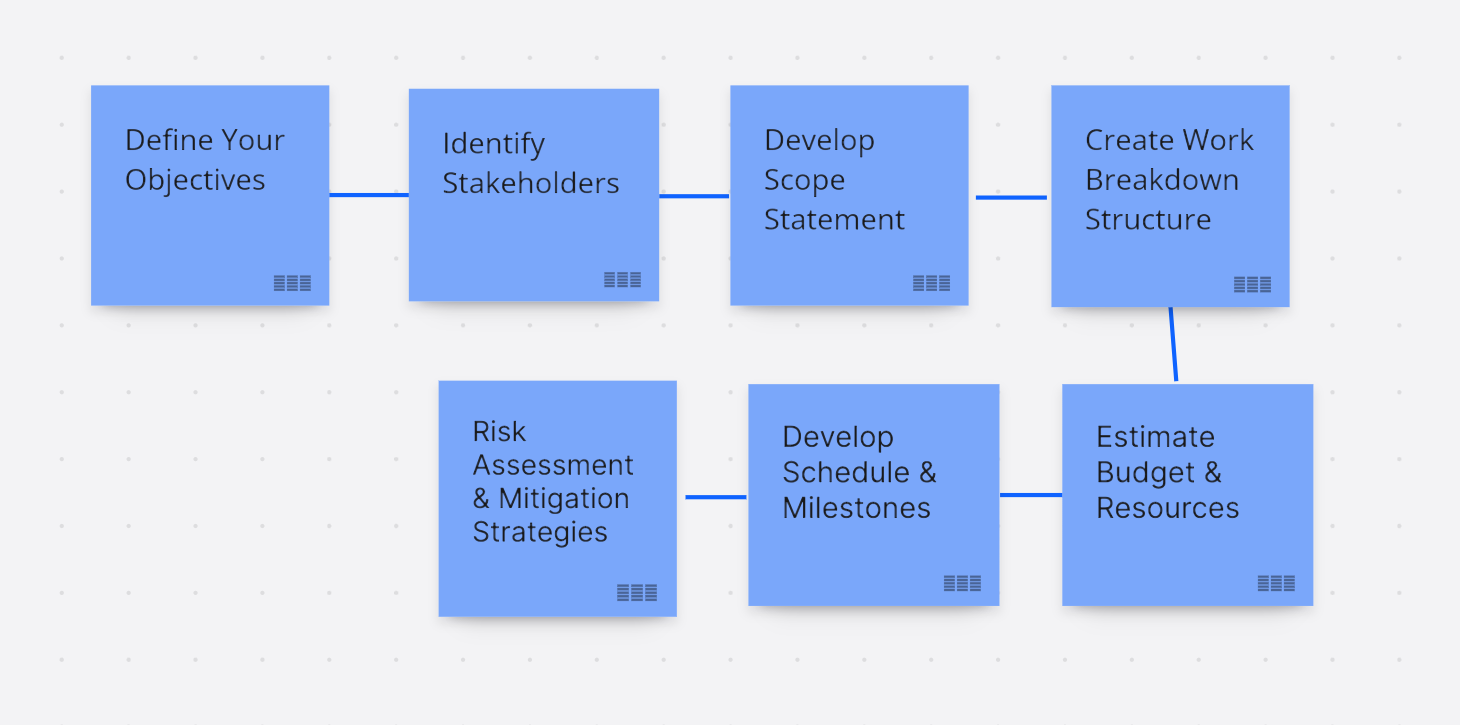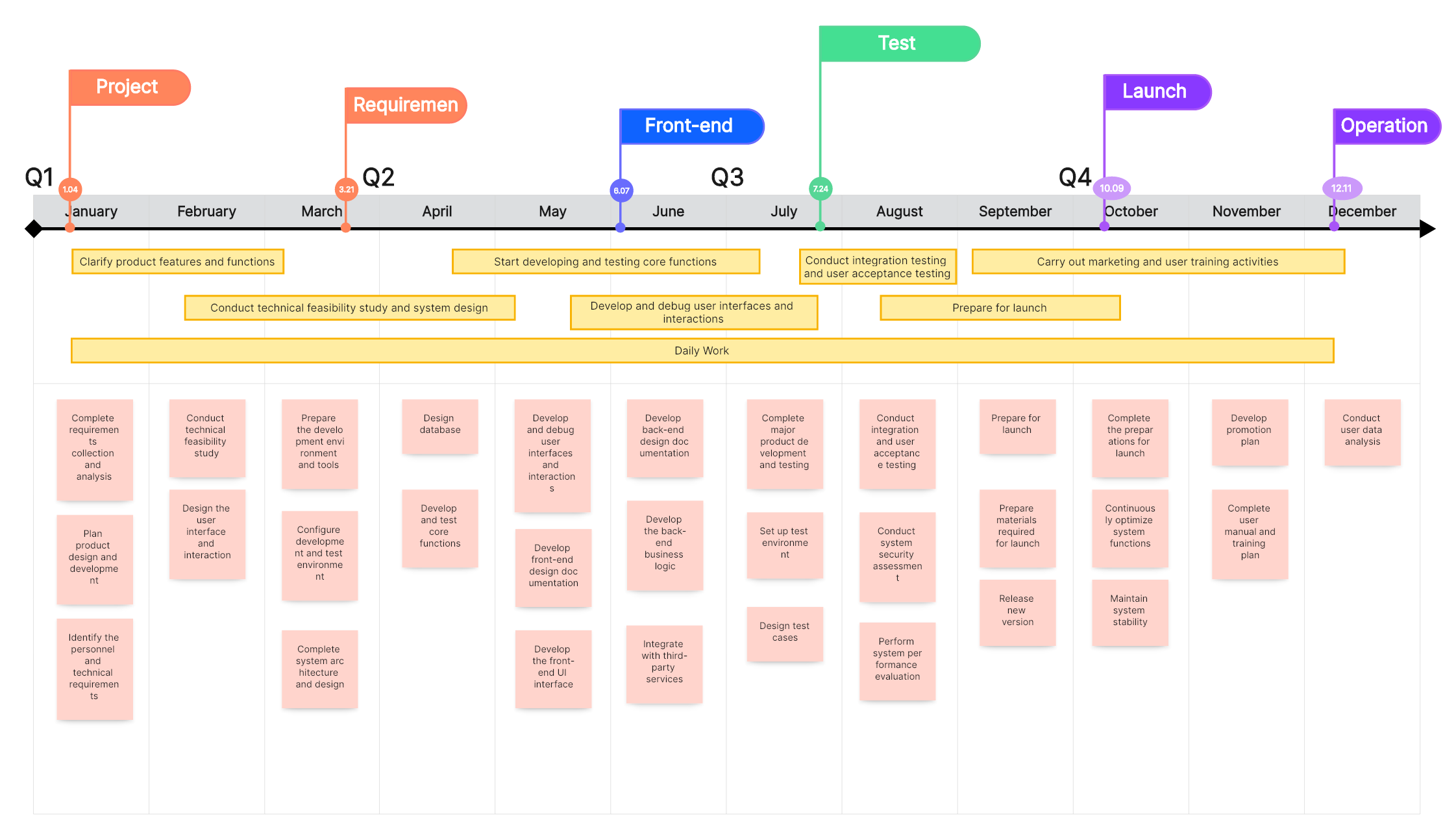Project planning is a critical aspect of any successful business venture. It provides a roadmap for achieving goals, managing resources, and mitigating risks. This article offers an in-depth look at project planning, its importance, and how you can master writing your own project management plan. Whether you're new to the field or looking to refine your skills, this guide will provide valuable insights.
Part 1. What Is Project Planning?
Project planning, the crucial second stage in the project management process, follows initiation and sets the foundation for a successful project. It involves meticulously outlining the steps required to achieve the project's objectives within a defined timeline and budget. This comprehensive process includes defining clear-cut goals, identifying necessary tasks, estimating resources and timeframes accurately, and developing an actionable plan. The aim is to create a roadmap that guides every aspect of the project execution, ensuring all team members understand their roles and responsibilities while keeping track of progress towards achieving the end goal.
Part 2. What Is a Project Plan?
A project plan is fundamentally a strategic blueprint that encapsulates your project's goals, objectives, tasks, timelines, and resources. It serves as an indispensable guiding document that provides comprehensive information to all stakeholders involved in the project. This includes not only what their specific roles and responsibilities are but also how these fit into the broader context of the project lifecycle. The plan outlines every detail from initiation to completion, ensuring everyone understands their part in achieving the overall objectives. It's a vital tool for communication and coordination, keeping everyone aligned and informed about progress and changes throughout the project's duration.
Part 3. Why Is the Project Plan Important?
The significance of a meticulously crafted project plan is paramount. It serves as a beacon, providing crystal clear clarity on what the project aims to achieve and the roadmap to accomplish it. This comprehensive document ensures that every stakeholder, from team members to management, understands their roles, responsibilities, and the steps required to reach the end goal. It's not just about listing tasks; it's about creating a shared vision and aligning everyone towards it. A well-structured project plan fosters effective communication, promotes transparency, mitigates risks by anticipating challenges, and ultimately ensures everyone is synchronized from inception to completion.
Part 4. What Should Be Included in a Project Plan?
A comprehensive project plan is a detailed document that encompasses several key elements, each playing a crucial role in the project's success.
- Objectives: These are the specific outcomes that the project aims to achieve. They provide direction and serve as benchmarks for measuring progress.
- Scope Statement: This outlines the boundaries of the project, detailing what will be included and what will not. It helps prevent scope creep, ensuring the project stays on track.
- Work Breakdown Structure (WBS): This is a hierarchical decomposition of the total scope of work to be carried out by the project team. It breaks down complex tasks into manageable parts, making it easier to assign, execute and control.
- Schedule & Milestones: The schedule provides a timeline for when each task should be completed. Milestones are significant events or stages in the project that help track progress and maintain momentum.
- Budget & Cost Estimates: This section details an estimate of what the project will cost based on resources required, labor, materials, etc. Regular monitoring ensures that costs stay within budget.
- Risk Management Plan: Identifies potential risks and outlines strategies for mitigating them.
- Communication Plan: Specifies how information will be disseminated among stakeholders throughout the course of the project.
- Quality Management Plan: Defines standards and procedures to ensure deliverables meet predefined quality requirements.
Each element contributes to creating a robust roadmap guiding your team towards successful completion of your projects.
Part 5. How to Write a Project Plan?
Writing an effective project plan is a thoughtful process that requires meticulous attention to detail. Here are some crucial steps you can follow:
- Define Your Objectives: Start by clearly defining what you aim to achieve with the project. These objectives should be specific, measurable, achievable, relevant, and time-bound (SMART).
- Identify Stakeholders: Recognize all individuals or groups who have a vested interest in the project's outcome. Understanding their expectations and concerns can help shape your plan.
- Develop Scope Statement: This involves outlining what the project will deliver (inclusions) and what it won't (exclusions). It sets boundaries for the project and helps prevent scope creep.
- Create Work Breakdown Structure (WBS): The WBS is a visual representation that breaks down complex tasks into manageable parts. It simplifies task assignment and makes tracking progress easier.
- Estimate Budget & Resources: Determine the resources required for each task and estimate costs accordingly. This step is crucial for financial planning and control.
- Develop Schedule & Milestones: Establish a realistic timeline for task completion. Also, identify key milestones - significant points in the project that indicate progress.
- Risk Assessment & Mitigation Strategies: Identify potential risks that could derail your project and develop strategies to mitigate them. This proactive approach can save time, cost, and resources in the long run.
Each of these steps plays an integral role in shaping your overall plan, ensuring it's comprehensive, actionable, and geared towards achieving your project objectives efficiently.
Part 6. Establish the Project Plan with Boardmix
Boardmix, with its intuitive and user-friendly interface, offers a powerful platform for crafting dynamic project plans. It's not just about creating a plan; it's about bringing it to life in an interactive, visual format that enhances understanding and engagement. With Boardmix, you can easily break down complex tasks into manageable parts, assign roles, set timelines, and track progress in real-time. What sets Boardmix apart is its collaborative feature - the ability to share your project plan with team members effortlessly. This promotes seamless collaboration as everyone can view updates, contribute ideas, and monitor progress collectively. Furthermore, Boardmix's robust features facilitate efficient resource allocation and risk management. In essence, Boardmix transforms the way you manage projects by making planning more organized, collaborative, and efficient.
Conclusion
Mastering the art of writing an effective project management plan is a critical skill for any successful venture, be it launching a new product or implementing organizational changes. This comprehensive guide provides you with the knowledge and tools needed to excel in this task. Coupled with Boardmix's powerful online whiteboard tool, which offers dynamic planning and collaborative features, you're not just equipped but empowered for success. Embrace this opportunity to elevate your project management skills and drive your projects towards their intended goals efficiently and effectively.













